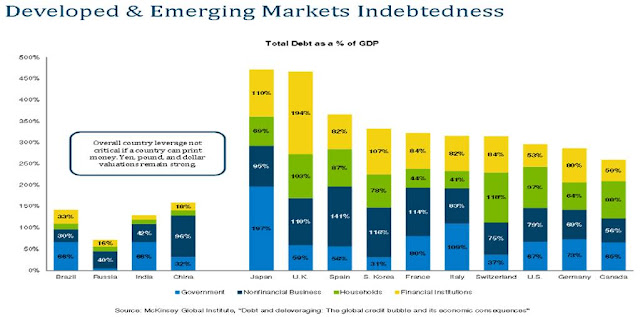 The analysis in the following
paragraphs is a clear example of soberness in contrast to the obsessive
irrationality and/or superstition prevailing in the Greek political scene. This
was taken from 'Fidelity Analyst Survey for 2013' publication without permission*.
The analysis in the following
paragraphs is a clear example of soberness in contrast to the obsessive
irrationality and/or superstition prevailing in the Greek political scene. This
was taken from 'Fidelity Analyst Survey for 2013' publication without permission*.Deleveraging and it's consequences will be felt for a long time
}The period from the early 1980s to the mid-2000s, now often described as
the ‘Great Moderation’, was one when a number of disparate factors (such as
demographics, monetary policy and deregulation) combined to create a positive
environment that facilitated rising asset prices, coupled with generally lower
macroeconomic volatility. The same backdrop also led to an unprecedented
increase in private sector debt in the developed world. The collapse of the US
subprime mortgage market was just the first chapter of a much broader global
debt crisis that affected individuals, financial institutions and, ultimately, governments.
}From an individual’s
perspective, excess debt can usually be reduced by belt tightening. From a
national perspective, the belt tightening option, via cuts in public sector
jobs for example is widely known as ‘austerity’. However, this approach has attracted
criticism from those who argue it is counterproductive because of its negative
impact on economic growth which results in lower tax receipts and potentially deflationary
effects (something that effectively increases the real value of debt).~
And it continues elsewhere:
}Many European countries will likely endure sustained periods of low
economic growth despite low interest rates. This is because with high national
debt to GDP, many governments need to go through a deleveraging process that is
structural rather than cyclical in nature. This constrains their ability to
spend on upgrading their infrastructure, whether it is physical (such as rails,
roads, or power grids) or social (such as education and healthcare). Our analysts
expect consumption in Europe to suffer from low economic growth and household
deleveraging.~
*These }...~ paragraphs appear as they were in the report. Data charts are from other sources.


No comments:
Post a Comment
You can post your feedback or comment. Please remember to be polite and brief.